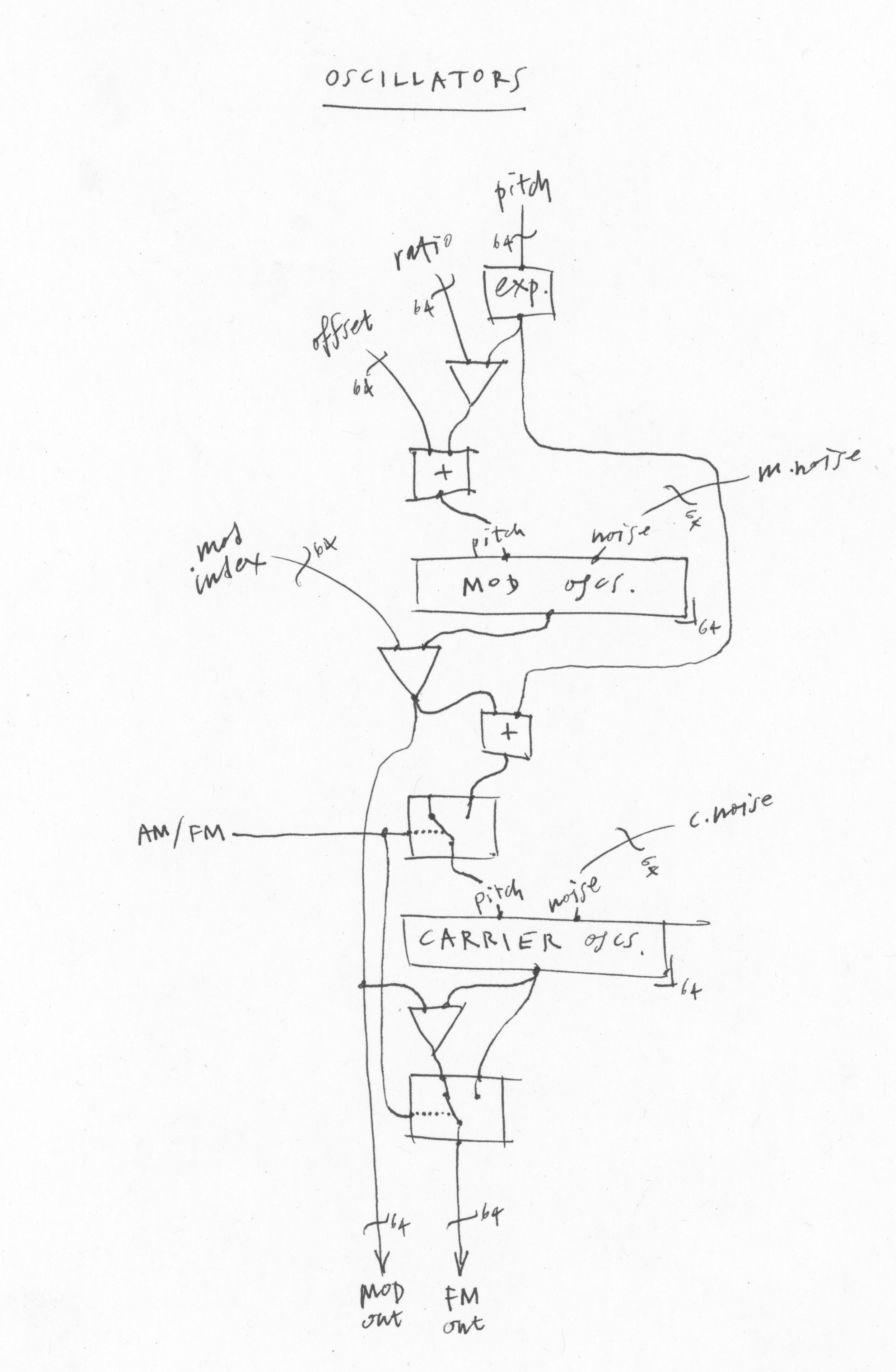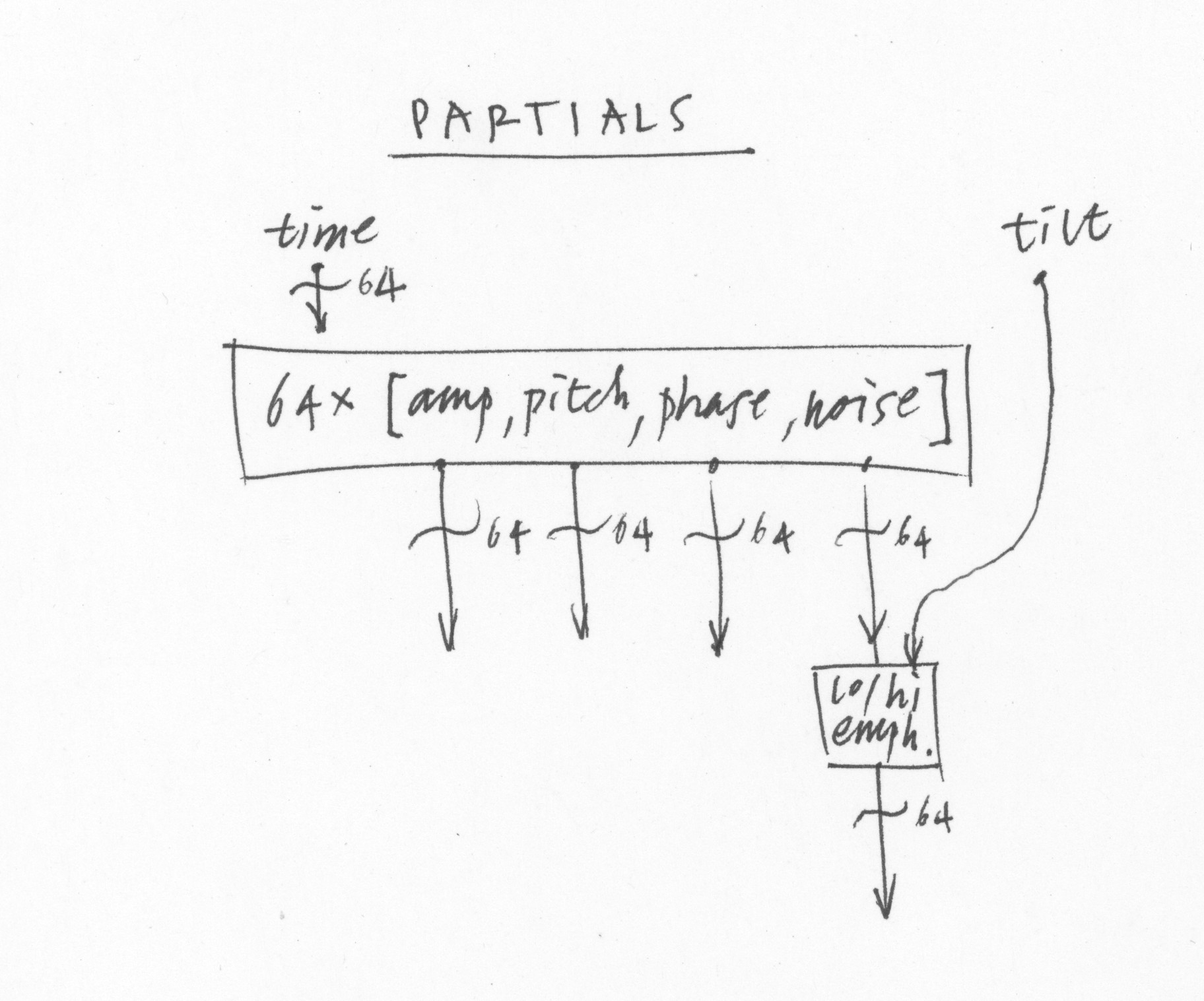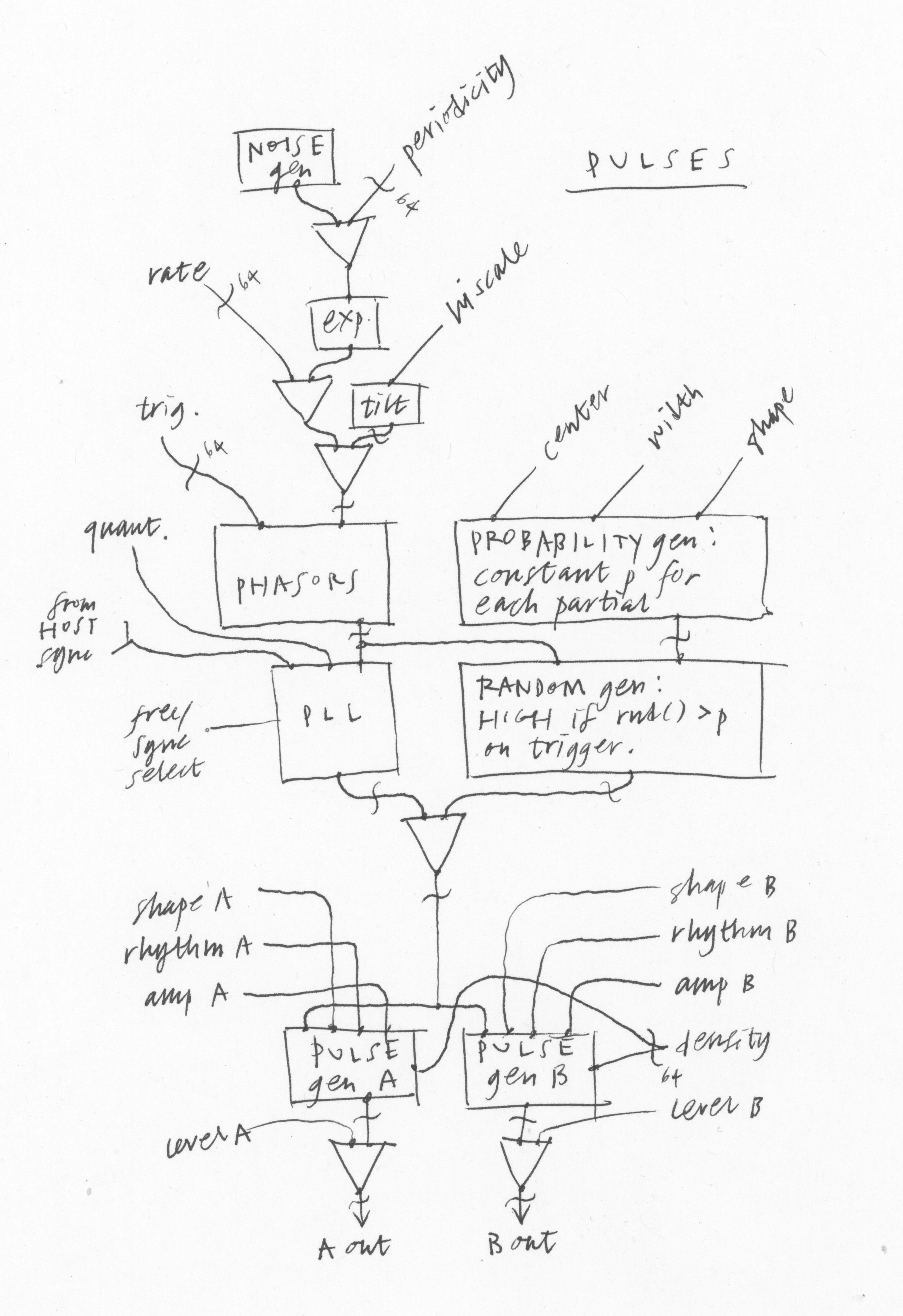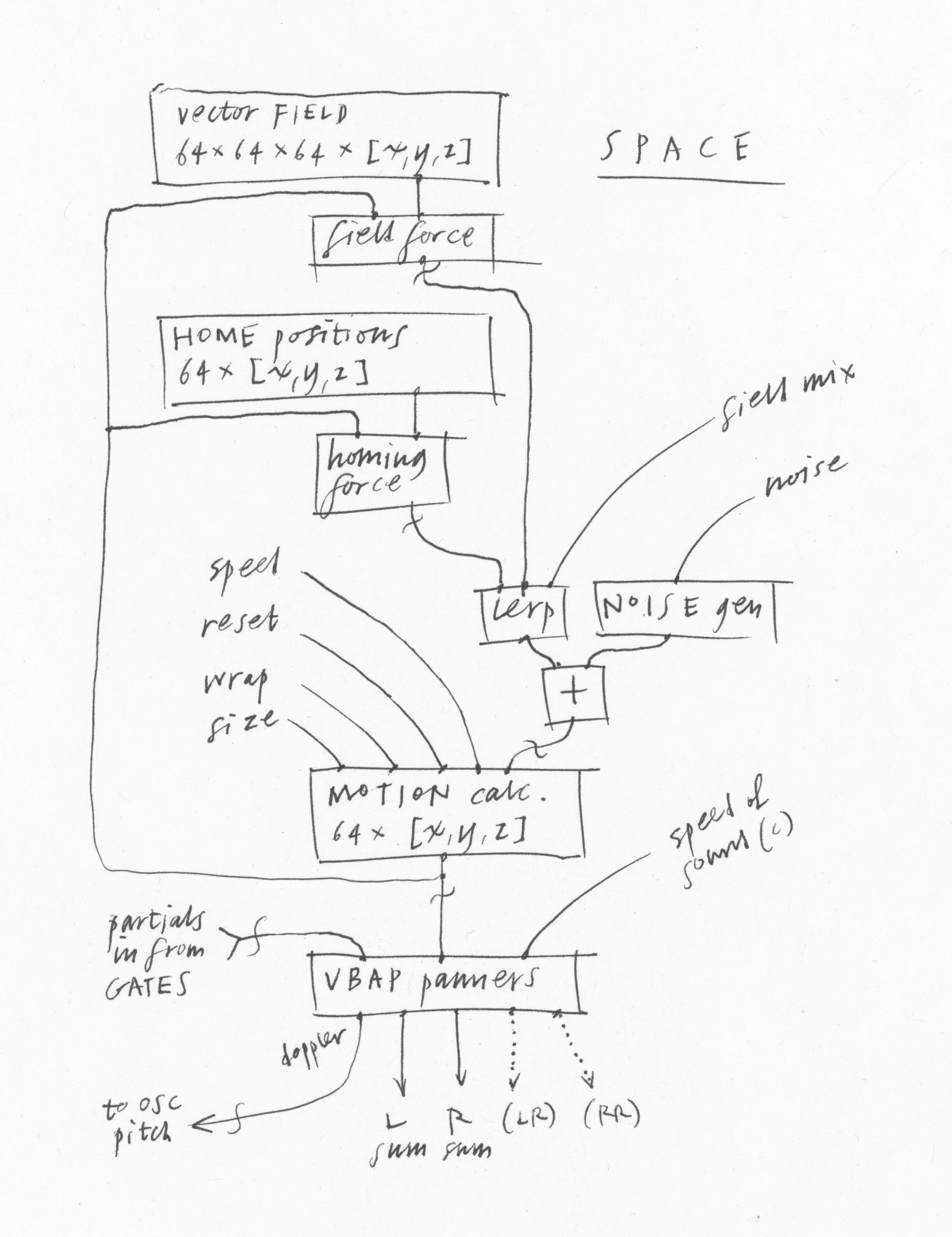
Sumu is an additive instrument that I've had in the works for a long time. Now that it's nearing completion and heading towards a public beta soon I'm going to break with the way I normally do things and put some detailed info out ahead of its release.

Sumu is another semi-modular instrument. It shares the general appearance of its patcher-in-the-center design with Aalto, Kaivo and Virta. As you can see, it's on the more complex end of the spectrum like Kaivo. Everything is visible at once and there are no tabs or menu pages to navigate, which suits the way I like to program a synthesizer tweaking a little something here, a little something there.
In the same way that Kaivo brought two different and compatible kinds of synthesis together, combining granular synthesis with physical modeling, Sumu combines advanced additive synthesis with FM synthesis.
What's most different about Sumu compared to my other synths is that the signals in the patcher are not just one channel of data, but 64—one for each partial in a sound! By keeping all these channels of data independent and still using the same patching interface, Sumu offers a very usable entry point into additive synthesis, and a range of musical possibilities that have only been approachable with high-end or academic tools or just coding everything yourself... until now.

Each of Sumu's oscillators is the simplest possible kind of FM:a single carrier+modulator pair. And the modulator can produce a variable amount of noise, which like the modulation ratio and depth can be controlled individually per oscillator. In a single voice there are 64 such pairs. Obviously a lot of sounds are possible with this setup—in fact, with the right parameters varying appropriately we can reproduce any musical sound very faithfully with this kind of oscillator bank.

There are a few ways of generating all of those control channels without the kind of painful per-partial editing that some of the first digital synths used. The first is the PARTIALS module up top, where you can see a diagram of all the 64 partials over time. This is like a sonogram style of diagram where x is time, y is pitch, and thickness of each like is amplitude. There is also an additional axis for noisiness at each partial.
A separate application will use the open-source Loris work by Kelly Fitz and Lippold Haken to analyze sounds and create partial maps.

Another way of generating control data is with the ENVELOPES module. It’s a normal envelope generator more or less—except that it generates 64 separate envelopes, one for each partial. Generally you would trigger them all at the same time, but each does have its own trigger so they can be separate. Using the “hi scale” parameter the high envelopes will be quicker than the low ones, making a very natural kind of lowpass contour to the sound.

Finally on the top row there’s the PULSES module. This combines an LFO and a randomness generator into one module. The intensity and other parameters of the pulses can be different for every partial. So this makes modulations that can be focused on a certain frequency range, but you don’t have to mess around editing partials one by one. You could also, for example, use the pulses to trigger the envelopes all at different times.
The PULSES module was inspired by my walks in a small canyon near my house, and listening to the very finely detailed and spatially spread sounds of water running in a small creek. Each drop contributes something to the sounds and the interplay between the parts and the whole is endlessly intriguing.
To make a water drop sound, two envelopes are needed at the same time: a rise in pitch and an exponential decay in amplitude. So PULSES lets you put out two such envelopes in sync. Then of course we generalize for a wider range of functions, so we can find out, what if the drops were quantized, or had different shapes over time? A voice turning into a running river is the kind of scene that additive synthesis can paint very sensitively. The PULSES module is designed to help create sounds like this.

The SPACE module lets us position each partial in the sound independently. Coming back to the creek idea, we can hear that certain pitch ranges happen in certain locations around us due to the water speed and the resonances of different cavities. This all paints a lively acoustic scene. By positioning many little drops independently, while allowing some variation, we can approximate this kind of liveliness.
This module centers around two kinds of data, a set of positions for each partial known as home, and a vector field: a direction [x, y, z] defined at each point in a 3-dimensional space. There will be a set of both the home and the field patterns to choose from. By offering these choices, and a small set of parameters controlling the motion of the partials, such as speed, the homing tendency, and the strength of the vector field, we can quickly create a wide variety of different sonic spaces without the tedium of editing each partial independently.
The RESONATORS module is very simple and inspired by the section of the Polymoog synthesizer with the same name. It’s simply three state-variable filters in parallel, with limited bandwidth and a bit of distortion for that “warm” sound. In Sumu, a synth we could otherwise describe as “very digital,” it’s nice to have a built-in way of adding a different flavor.
So I have this interface you see above, and a sound engine, and I'm working feverishly to marry the two. To enable all of the animations and the new pop-up menu, I wrote a whole new software layer that provides a completely GPU-based UI kit and interfaces directly with the VST3 library. Because it's been such a long process this time, I'm going to "build in public" more than I am used to doing, and have a public beta period. My plan is for this to start in December. Meanwhile I hope this information gives you interested folks something to whet your appetites, and even a basis for starting to think about what kinds of patches you might want to make.
A very interesting concept! I have been wanting to learn to code so I can do DSP work, but I also want to be making music and such intriguing tools have become so readily available… =^_^=
Cannot wait! Thanks for all this creative work Randy - love your synths!
I'm very much looking forward to this.
Each of your synths has been an inspiration.
And I do love the new popups.
They are such a unique and beautiful extension to your design language.
looks great .. pretty much the only software vendor which makes the prospect of fighting an ageing buzzkill computer seem worth the effort - this new addition may ask too much of the trusty late '12 mini but the M1/pro mini can't be far off (hope it's within budget) ... Sumu looks tantalising !
Such a good piece of design and concept for a synth. The 64 partials existing in one signal path reminds me of the multi-channel side of Max. Look forward to it!
Wow, I´m really exited about that for a very long time. Will you publishing any peek-a-boo audiofile snippets teasers? This looks so promising. May become one of the most interesting soft-synthesizers of recent times. Category own custom development. I literally can feel the signature sound by looking at this GUI and knowing the other Madrona synths.
Also great you are updating AaltoVerb to 2.0. Great sound and the additions will push it foreward alltogether.
Only thing I wish was a savable code-file (you know it´s still not working for me in any form, except going copy/paste directly from your homepage). ;););)
Best for coding and enjoy the progress
Mats
Very excited to try this new synth! Thank you for the updating us on it's development.
Such a good piece of design and concept for a synth. The 64 partials existing in one signal path reminds me of the multi-channel side of Max. Look forward to it!
Thanks for all the kind words!
wonder if I should sell my Paca.
I wouldn't!
Will the partials file import be in proprietary format or simple text that can potentially be outputted from OpenMusic or SPEAR?
It will definitely be open and documented. It's just text for now—this could change for performance reasons.
"learn" can only be for midi learn functionality, right? Please add that to Aalto and the others as well in the future :-)
Yep! A bit annoying to do with VST3, which has been one of the stumbling blocks this year. But such is life
Is 64 partials using the parallel side of the Intel processor?
Yep! (and ARM)
That look great Randy. My only concern is the GPU utilisation.
You should not need a powerful GPU. typically I'm using the built-in one on my Macbook Air.
In my relatively short music adventure (going on 3 years now since I got into all this stuff), never have I ...
thank you!!
Wow, I´m really exited about that for a very long time. Will you publishing any peek-a-boo audiofile snippets teasers?
for sure!
Only thing I wish was a savable code-file (you know it´s still not working for me in any form, except going copy/paste directly from your homepage).
This should work, please email me for support.
This looks really amazing. I'm curious about the SPACE module. Is the plugin multi-channel out? I see reference to the L/R sums, and Left Rear and Right Rear. I'm curious how this would integrate with quad, 5.1, ambisonics, atmos etc.
looks very interesting :)
nice to see direct lfo and learn modulations.
(will learn be multi channel ... mpe/osc? can we attenuate it?)
I'm intrigued by the 'time' input too
Can’t wait!
After looking/reading over everything, the synth looks incredible to say the least. To say I am looking forward to using it is an understatement. Can't wait!
Yes! I can't wait to play it soon...
This looks incredibly cool, such a unique take on additive
can we have it for christmas, Randy?
Or even just a short video letting us hear it. After Christmas of course. :)
I was working hard to get it out last week but got sick and now it's Christmas eve all of a sudden. More soon, then, after a little break. Happy Holidays.
Count me in!
get well soon!
thank you! I"m getting there.
I'm in, as you already know Randy :)
can not wait to hear and play with Sumu..!
also...get well soon!!!
Yikes. Get well soon. A healthy creator is a requirement for a healthy creation and Sumu will be worth the wait.
Hope your holidays improve and you ring in the new year with wellness and inspiration.
This sounds so fantastic and fun! Can’t wait to try it.
Happy New Year and Happy New Sumu!! Definitely would love to try it in the public beta. It will be surely interesting cause a lot of partials are a lot of data to work with!!
And obviously don't forget to rest :))
Can't wait to give Sumu a spin! Very exciting!
Looks great. Can not wait to abuse it !
on pins and needles to try this out, it looks super fun!
I can't wait to try this puppy out. Aalto and Kaivo are so fun and powerful and this looks great as well. Congratulations on your progress on this new one.